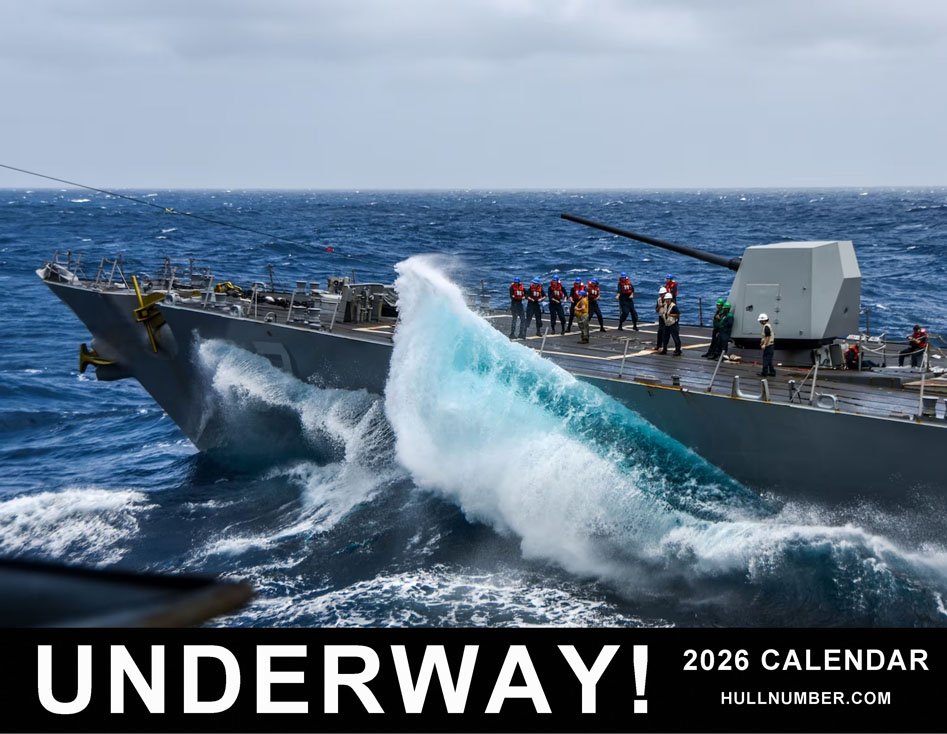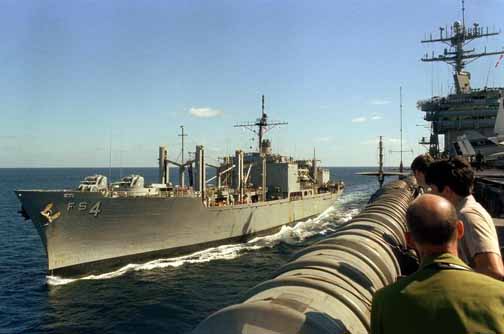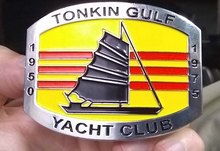 |
|||||||
| UNDERWAY! 2026 WALL CALENDAR is AVAILABLE - CLICK HERE |
|||||||
 |
|||||||
 |


U.S.S. WHITE PLAINS
(AFS-4)THE ORIENT EXPRESS IS AT YOUR SERVICE!
Click to view crew list
The USS WHITE PLAINS (AFS-4), a Mars class combat stores ship, was commissioned on 23 NOV 1968. USS WHITE PLAINS served her country for 26 years, 4 months and 25 days, until decommissioned on 17 APR 1995. USS WHITE PLAINS was built in San Diego by National Steel and Shipbuilding. After fit out and shake down training, she began a series of Western Pacific deployments that made up the bulk of her career. Early deployments were bound for Vietnam waters, later deployments supported US Naval forces in the Persian Gulf. Surviving fires and typhoons, USS WHITE PLAINS, "The Orient Express", delivered the goods until her decommissioning in April 1995. The hulk of WHITE PLAINS was sunk as part of a multi-national fleet exercise off of Hawaii in 2002.
The USS WHITE PLAINS (AFS-4) deployment history and significant events of her service career follow:
AFS-4 Deployments - Major Events
| Add a AFS-4 Shellback Initiation | Add a AFS-4 Deployment - Major Event | ||||
| Month | Year | to | Month | Year | Deployment / Event |
|---|---|---|---|---|---|
| JUN | 1959 | - | Shellback Initiation - 22 JUN 1959 - Pacific Ocean | ||
| OCT | 1965 | - | Keel Date: 2 OCT 1965 at National Steel and Shipbuilding Company San Diego CA | ||
| JUL | 1966 | - | Launch Date: 26 JUL 1966 | ||
| JAN | 1968 | - | JAN | 1969 | Commisioning |
| JAN | 1968 | - | JAN | 1971 | West Pac |
| APR | 1968 | - | Shellback Initiation - 10 APR 1968 - Pacific Ocean | ||
| NOV | 1968 | - | Commissioned: 23 NOV 1968 | ||
| JAN | 1969 | - | JAN | 1970 | West Pac-Viet Nam |
| JUN | 1969 | - | OCT | 1969 | fleet work study group wespac |
| JUN | 1970 | - | DEC | 1970 | West Pac-Viet Nam |
| JUL | 1970 | - | DEC | 1970 | West Pac-Viet Nam |
| SEP | 1970 | - | Shellback Initiation - 9 SEP 1970 - Pacific Ocean | ||
| NOV | 1971 | - | JUN | 1972 | West Pac-Viet Nam |
| NOV | 1971 | - | JUN | 1972 | West Pac |
| DEC | 1971 | - | JAN | 1972 | Sent to Indian Ocean during Pakistan and India conflict |
| JAN | 1972 | - | JUN | 1972 | West Pac-Viet Nam |
| FEB | 1972 | - | Shellback Initiation - 8 FEB 1972 - Pacific Ocean | ||
| NOV | 1972 | - | SEP | 1975 | Homeported in Sasebo Japan |
| JAN | 1973 | - | JAN | 1973 | West Pac |
| JAN | 1973 | - | JAN | 1975 | West Pac-Viet Nam |
| FEB | 1973 | - | JAN | 1975 | West Pac-Viet Nam |
| MAR | 1973 | - | AUG | 1973 | West Pac-Viet Nam |
| APR | 1973 | - | Shellback Initiation - 9 APR 1973 - Pacific Ocean | ||
| JAN | 1974 | - | MAY | 1974 | West Pac-Viet Nam |
| FEB | 1974 | - | MAY | 1974 | West Pac-Indian Ocean-Persian Gulf |
| JUL | 1974 | - | SEP | 1974 | West Pac-Indian Ocean-Persian Gulf |
| APR | 1975 | - | MAY | 1975 | South China Sea. OPERATION FREQUENT WIND (Evacuation of Saigon) |
| JUL | 1976 | - | Shellback Initiation - 20 JUL 1976 - Indian Ocean | ||
| JUL | 1976 | - | Shellback Initiation - 20 JUL 1976 - Pacific Ocean | ||
| JAN | 1977 | - | JAN | 1978 | West Pac-Indian Ocean |
| JUL | 1978 | - | Shellback Initiation - 20 JUL 1978 - Indian Ocean | ||
| APR | 1979 | - | Shellback Initiation - 22 APR 1979 - Indian Ocean | ||
| SEP | 1979 | - | SEP | 1980 | Mediterranean-Indian Ocean |
| SEP | 1979 | - | SEP | 1980 | Mediterranean-Indian Ocean |
| NOV | 1979 | - | JUL | 1980 | West Pac-Indian Ocean-Persian Gulf |
| MAY | 1981 | - | Shellback Initiation - 9 MAY 1981 - Pacific Ocean | ||
| APR | 1982 | - | Shellback Initiation - 18 APR 1982 - Indian Ocean | ||
| APR | 1982 | - | Shellback Initiation - 18 APR 1982 - Pacific Ocean | ||
| APR | 1982 | - | Shellback Initiation - 18 APR 1982 - Indian Ocean | ||
| DEC | 1982 | - | MAR | 1983 | Installation of CIWS (Close In Weapon System) Yokosuka Japan |
| AUG | 1983 | - | MAR | 1984 | Mediterranean-Indian Ocean-Persian Gulf |
| AUG | 1983 | - | Shellback Initiation - 31 AUG 1983 - Indian Ocean | ||
| JAN | 1984 | - | JAN | 1985 | West Pac-Indian Ocean |
| SEP | 1984 | - | OCT | 1984 | Homeport shifted from Yokosuka Japan to Guam |
| NOV | 1984 | - | Shellback Initiation - 7 NOV 1984 - Indian Ocean | ||
| NOV | 1984 | - | NOV | 1986 | WestPac |
| JUL | 1985 | - | Shellback Initiation - 29 JUL 1985 - Indian Ocean | ||
| JUL | 1986 | - | Shellback Initiation - 27 JUL 1986 - Pacific Ocean | ||
| MAY | 1989 | - | MAY | 1989 | Fireroom fire killing 6 men. |
| JUL | 1990 | - | NOV | 1990 | West Pac-Indian Ocean-Persian Gulf |
| AUG | 1990 | - | NOV | 1990 | Desert Shield |
| SEP | 1990 | - | Shellback Initiation - 16 SEP 1990 - Pacific Ocean | ||
| SEP | 1990 | - | Shellback Initiation - 16 SEP 1990 - Pacific Ocean | ||
| MAY | 1991 | - | OCT | 1991 | Desert Storm |
| SEP | 1992 | - | SEP | 1992 | Typhoon Omar- torn from mooring beached on Polaris Point - Guam |
| SEP | 1993 | - | AUG | 1994 | West Pac-Indian Ocean-Persian Gulf |
| SEP | 1993 | - | AUG | 1994 | Desert Shield |
| NOV | 1993 | - | Shellback Initiation - 30 NOV 1993 - Indian Ocean | ||
| NOV | 1994 | - | Shellback Initiation - 30 NOV 1994 - Indian Ocean | ||
| JAN | 1995 | - | Shellback Initiation - 14 JAN 1995 - Pacific Ocean | ||
| APR | 1995 | - | Decommissioned: 17 APR 1995 | ||
AFS-4 General Specifications
Class: Mars-class combat stores ship
Named for: White Plains
Complement: 42 Officers and 445 Enlisted
Displacement: 17500 tons
Length: 581 feet
Beam: 79 feet
Flank Speed: 21 knots
Final Disposition: Sunk as target 2002
USS WHITE PLAINS (AFS-4)
The
second White Plains (AFS-4) was laid down on 2 October 1965 by the
National Steel & Shipbuilding Co. at
San Diego, Calif.; launched on 26 July 1966; sponsored
by Mrs. Bob Wilson; and commissioned at the Long Beach Naval Shipyard on 23 November 1968, Capt. Thomas B. Brenner in command.
The
combat stores ship spent the first nine months of her commissioned service engaged in a series of
routine post-commissioning activities in California waters. In February 1969, she went through a series of
qualification trials in preparation for her
final contract trials which she passed successfully in mid-March. Shakedown training followed in April, and
post-shakedown availability at the
San Francisco Bay Naval Shipyard
occupied her time during the last half of May and the first three weeks of June. During the second week in July, the ship participated in her
first fleet exercise, Operation
"Beagle Baron." She spent the
last half of the month making preparations for her first deployment to the western Pacific. On 20
August, White Plains stood out of San Francisco Bay and shaped a
course for the Far East. On 3 September, she reached
her first port of call in the Orient, Yokosuka. While in Japan, she also visited Sasebo before getting underway on 16 September for Subic Bay and thence to the Vietnam combat zone. After topping off her
replenishment cargo at Subic Bay, the ship arrived in Vietnamese waters on 23 September. There, she
cruised for 14 days engaged in underway replenishment opera-tons with warships of the 7th Fleet on station off
the coast. The deployment lasted for another four months during which she made three more replenishment
cruises in the combat zone along the
Vietnamese coast. On 11 February
1970, White Plains departed Subic Bay on her way home. She stopped at
Pearl Harbor near the end of the
month and arrived in San Francisco on 5 March.
The combat stores ship
remained in the United States only three
months. During that time, she took the normal
post-deployment standdown break, underwent a restricted availability, and conducted refresher and type training. On 10 July, she headed back to the western Pacific for her second tour of duty in the Vietnam conflict. She reported for duty with the
7th Fleet on 22 July and, between that time and early December, made five different replenishment
cruises in the combat zone. On 8 December, the ship departed Yokosuka, Japan, to return to the United States.
She arrived back in San Francisco on
18 December and immediately commenced
post-deployment standdown. On 15 April
1971, she began her first regular overhaul at Hunters Point Naval Shipyard, and it occupied her until 8 July
when she put to sea for post-overhaul trials. Type
and refresher training took up the remainder of July as well as August
and September. In October, she began
preparations for her third deployment to the western Pacific.
On 20
November, White Plains stood out of San Francisco Bay on her way to the Far East and, after
a two-week voyage,
arrived in Subic Bay on 7 December. Again, she made a series of replenishment cruises in the
Vietnam combat zone and punctuated them with visits to such ports as Hong Kong; Singapore; Sattahip, Thailand; Kaohsiung, Taiwan; and Subic Bay. She remained in the Far East for over seven months and
conducted 10 replenishment cruises to
Vietnamese waters. On 8 July 1972, White Plains departed Sasebo, Japan, and shaped a course for home. She arrived
at Oakland, Calif., on 19 July and
remained there until 5 September at
which time she moved to Alameda for a restricted
availability at the Todd Shipyard. The ship completed repairs on 3 October and
began preparations to return to the
western Pacific. On 31 October, the combat
stores ship got underway from Alameda and set a westerly course. After a two-week voyage, she entered her
new home port, Sasebo, on 13 November. There, she immediately began another
restricted availability, this time for
conversion of her propulsion system to the use of Navy distillate fuel. That
conversion took up the remainder of 1972 and the first 15 days of 1973.
White
Plains' return
to duty coincided with the end of American involvement in the Vietnam war; however, that did not signal an end to duty in Vietnamese
waters. Through the first seven months of
1973, she continued to make
replenishment cruises in the former combat zone to bring stores to the American ships engaged in Operation
"End Sweep," the taking up of mines planted by the Navy in North Vietnamese waters during the war. "End
Sweep" came to a conclusion late in July, and White Plains began
real peacetime duty at that point.
For the next two years, she operated out of Sasebo making periodic voyages to provide supplies to units of the Fleet at sea. She also made the usual port calls throughout the Orient and participated
in training exercises, notably with
units of the Republic of Korea Navy
in November of 1974 and January of 1975.
On 1 August 1975, she changed home ports from Sasebo to Yokosuka and, on 5
September, began regular overhaul at
her new base of operations. That repair period lasted until 15 April 1976 at which time she resumed her
replenishment duty with the 7th Fleet.
The year
1976 proved a very active one for White Plains. In
addition to her normal duty supplying the 7th Fleet,
she joined in three non-routine operations. Late in May and early in June, she voyaged to the Mariana Islands where Typhoon Pamela had just wreaked so much havoc. The ship carried supplies to the
relief of the storm-battered island of Guam. During the second week of
July, she interrupted her normal routine again, this time to rush to the Indian Ocean, via Subic Bay, to resupply the carrier contingency force sent to
patrol the eastern coast of Africa during the flare-up between Kenya and
Uganda. She remained in the Indian Ocean until
5 August whereupon she headed back to Yokosuka to resume her normal
support duties with the 7th Fleet. On 27
September, she departed Yokosuka for another special mission. During the next five weeks, she sailed to Australia, participated in the bilateral
amphibious and antisubmarine exercise Operation "Kangaroo II,"
visited the Australian port of Townsville,
and then returned to Yokosuka. She
arrived back in her home port on 11
November and resumed her duties keeping the fleet supplied. Since that time, White Plains has continued to make replenishment swings from Yokosuka
to 7th Fleet units operating in such diverse places as the Philippine Sea, the South China Sea, and the
Sea of Japan. In late October and
early November of 1977, the ship
voyaged to the Indian Ocean again to replenish American warships engaged in Operation "Midlink." Upon concluding that mission, she returned to
Yokosuka and resumed her replenishment
duties out of that port. As of January 1979, she continued to operate from Yokosuka
in support of the 7th Fleet.
White
Plains (AFS-4)
earned seven battle stars during the Vietnam conflict.
[Note: The above USS WHITE PLAINS (AFS-4) history may, or may not, contain text provided by crew members of the USS WHITE PLAINS (AFS-4), or by other non-crew members, and text from the Dictionary of American Naval Fighting Ships]
